
In sales, success ultimately comes from closing deals. It’s only when the agreement is signed, and the money is in the bank that a sale truly counts. The first crucial step in the sales process is prospecting.
Prospecting — the activity of finding new potential customers and discovering if your
product or service is a good fit for their needs.
Sales professionals have more opportunities and platforms than ever before to prospect for new customers. These opportunities include the phone, email, social media, networking, referrals, video and even posts.
Historically, cold calling has reigned supreme. It has been the critical activity for sales teams to create new sales opportunities and a pipeline. Most sales teams generate a pipeline of prospects by making hundreds of cold calls each day.
With cold calling as the reigning king, it only makes sense that the phone has served as the main channel of communication; however, that is changing rapidly. The phone remains one of the most used sales tools, but sales professionals are increasingly turning to social media to help them with prospecting, customer relationships and sales engagement.
 Over the last few years, there has been a constant debate between proponents of cold calling and social selling. On the one hand, traditional sales professionals and experts have labelled social selling as a fad or referred to it as a marketing activity. On the other hand, social sellers have highlighted the dropping numbers of answered calls,
Over the last few years, there has been a constant debate between proponents of cold calling and social selling. On the one hand, traditional sales professionals and experts have labelled social selling as a fad or referred to it as a marketing activity. On the other hand, social sellers have highlighted the dropping numbers of answered calls,
and the rise in time spent on social media.
The debate has largely manifested from the challenge that the shift in sales
tactics brings. We are going through a change in the way we communicate,
the way we buy and, in turn, the way we sell.
VanillaSoft’s Darryl Praill and leading social selling expert Daniel Disney
even went toe-to-toe in a hugely popular online debate. With over 1,000
salespeople joining in from around the world, it was certainly one not to miss.
Want to check it out? You’re in luck; you can catch up on the full debate here.
What insights did the debate yield when it comes to cold calling versus social
selling? That cold calling and social selling are a dynamic duo when used together.
While the debate has always been cold calling VERSUS social selling, the answer has actually been cold calling AND social selling. You don’t have to choose one or the other; instead, leverage these tactics together.
As previously noted, there are several key platforms for communication. What salespeople sometimes fail to realise is that preferences vary. Some people prefer
to use the phone, but others may favour email, social, video, text or some other form of communication. It is essential to establish this preference early to help stay in front of your prospective customer.
The only way you can truly reach the maximum number of prospects is by using all of these platforms. Even more important, be sure to keep following up. You should be using at least two channels; however, using three to four is even better. Utilising a defined cadence to connect with each contact is vitally important in sales engagement and in leading the prospect to a sale. It is also important that when you get the deal, you continue to follow up for future sales and referrals.
Whether you’re a veteran cold caller just starting with social selling or a social seller who wants to improve your cold calling skills, there are some foundational steps you need to take to ensure success on both fronts. Let’s delve into those foundational areas now.
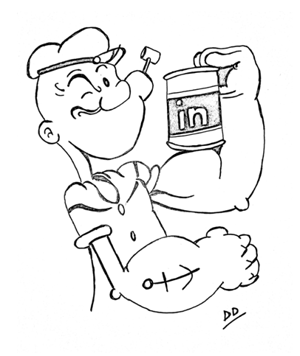 Optimise Your LinkedIn Profile for Post Cold Call Views
Optimise Your LinkedIn Profile for Post Cold Call ViewsRegardless of whether your first touch is a cold call or a social message, you need to optimise your LinkedIn profile. Why? The people with whom you connected online or spoke to on the phone will want to learn more about you. Show them you are worth their time by putting your best foot forward with a well-constructed and optimised profile.
Pay close attention to the elements below. These aspects can make or break your presence.
Let’s start with one of the most critical components of your profile, your profile picture. We’ve seen some great ones and some not so great ones over the years. We know it’s not always easy finding a suitable photo to use, which is why we often see photos from weddings (usually the last time you had a nice picture taken when you dressed smartly!). These days, the reality is that most people reading this will have a smartphone with a pretty powerful camera, so next time you’re in the office get a colleague to take a decent headshot against a plain background and boom, perfect profile picture!
Behind your profile photo is space for you to upload a background image. Please don’t ignore this part; it’s fine to choose a plain background or upload a generic one. However, remember that you can create a custom one for free using Canva. You can include your company logo or mission statement or even your contact details, something that looks professional, catches attention and builds your brand.
The next step is the headline. This field is often just populated with your job title, which is fine. However, you can be a little more creative and make it more about what you do or what you can offer.
For example, Daniel uses LinkedIn to grow his personal brand, so his headline talks about him, but you might want to discuss what you provide or how you can help your target customer. The headline is also an excellent place to put searchable terms that will aid potential prospects in finding you. Words or phrases that include your industry and “sales” are very helpful such as “Pharmacy Sales Professional” or “Computer Technology Sales”.
You could also try using something like: “Helping people do X by using Y to solve Z.”
This section is your opportunity to give a nice elevator pitch. It should include a summary about you, what you can offer, achievements that help prove your ability to deliver and your contact details.
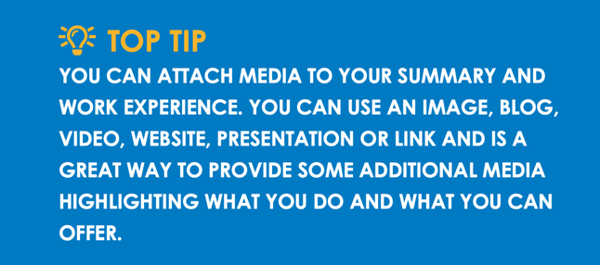
We know your contact details are available on your profile, but you should want them to be as clear as possible so putting them into the summary box helps make them even more visible. Including your contact information here is also crucial since your summary is the only info that shows up when people view LinkedIn on a mobile device. Save your profile visitors time by not requiring them to search any further than your summary information to get in touch with you. As silly as it sounds, this extra effort could often mean losing a sale.
This area will show all of your activity on LinkedIn including posts you liked, commented on or shared. This section will also show the blog posts that you wrote on LinkedIn. Articles & Activity is another place your prospect may look so it’s important to be aware of what content you like, and how you engage with others, as your prospects may see it.
This section is for you to list your past and current work experience. Less is often more in these sections but give your prospect the opportunity to see what experience you have and how it may relate to your ability to provide value to them.
The Work Experience section is also an excellent place to include a little more about your current company and what makes them different/unique. There is also the ability to add media, so you can link the company website, include your sales pitch presentation, a video and media that will help the prospect buy into what you do.
This section is one of the real standout features of LinkedIn as both a fantastic recruitment platform and sales platform. In this section, potential buyers can see areas where you have been endorsed.
For example, if you were selling software and your prospect could see that others have endorsed you for “Software”, “Account Management”, “Customer Service” etc., it helps them feel more comfortable buying from you.
Taking it one step further, not only can people endorse you for skills, but they can write a full personal recommendation! Imagine how powerful it would be if you’re selling software and your prospect visits your profile and sees several recommendations from other software companies talking about how much you helped them, saved them money, listened to them, etc. Don’t you think this would make them want to work with you more?
The Accomplishments section provides you with an opportunity to list any courses, certifications or awards that you’ve received. A prospect viewing your profile and being able to see your qualifications, adds some real power to how potential customers perceive you.
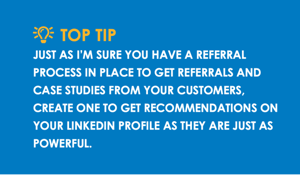 Interests
InterestsYou might not think this would be important to a prospect but think about this, they look at this section and see that you were interested in key industry companies or pages, it would show them that you’re interested in their business and helping them to succeed.
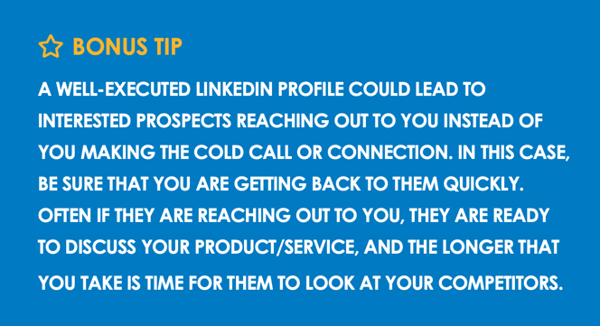
We’ve discussed how to get your social presence in order for the post-cold call credibility check. Now, let’s review ways to improve your cold calling game.
Yes, very few salespeople actually enjoy call role-playing, however,
you can improve your performance with this exercise. Ask a colleague or your manager to spend some time practising different call scenarios that you are likely to encounter. Here are a few recommendations to get the most out of this exercise:
Start with a Script - A script gives you a foundation for the call and guides you where to go. You don’t need to read the script. Treat it as a guide in both your roleplaying and live sales calls.
 Don't Just Focus on What You're Saying; Practice Listening, Too - The best cold call role-playing will make you work on your listening and comprehension skills. The best cold callers take time to hear what the prospect has to say. He or she will also listen for non verbal clues -- the tone of voice, pauses, and so forth -- to gauge the person’s trust and interest levels.
Don't Just Focus on What You're Saying; Practice Listening, Too - The best cold call role-playing will make you work on your listening and comprehension skills. The best cold callers take time to hear what the prospect has to say. He or she will also listen for non verbal clues -- the tone of voice, pauses, and so forth -- to gauge the person’s trust and interest levels.
Practice Dealing with Rejection - Don’t allow your role-play partner to give you easy wins, especially if you’re new to or uncomfortable with cold calling. Ask your partner to make some calls end with rejection. You need to practice dealing with rejection and reminding yourself that rejection isn’t personal.
Treat the Exercise Seriously - Don’t just blow through the roleplaying scenario to get it out of the way. Treat it seriously and follow out each scene to its conclusion. Talk to your partner about what went well and where you can improve.
Remember to Practice Your Voicemail Message, Too - In this day and age, the chances are that you won’t always get a live person on the line. Practice your voicemail delivery and ask your partner to critique you. Consider using a voicemail script, too.
Ask for Feedback - If your roleplaying partner isn’t giving you feedback, ask for it. You need to hear constructive criticism to help you improve your technique.
Another way to take your cold calling efforts to the next level is to review recordings of your live calls. You can do this alone or with your manager or a colleague.
Listen to the full call together first. Next, run back through the conversation pausing the recording to discuss both the high points and the opportunities for improvement
Another significant change that social media has brought to sales is to enhance and make relationship management more efficient. One common tactic in sales is to give 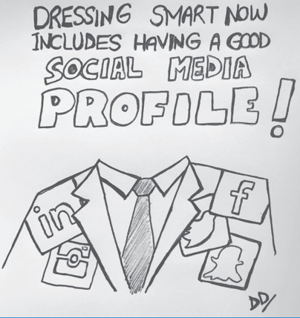 your customer a call once every 3-6 months to “check in”. These are often very sales-like conversations, usually just making sure the customer is happy and potentially
your customer a call once every 3-6 months to “check in”. These are often very sales-like conversations, usually just making sure the customer is happy and potentially
identifying any more opportunities to upsell.
However, social media gives you the opportunity to maintain and grow customer relationships on a far more regular basis. The point here is to be persistent, consistent and establish a cadence to make sure that you are keeping your product or service in the prospect’s mind.
The right content can help you connect and build relationships with prospects and customers. Try these content tips in your sales efforts.
Content creation helps you cement the relationship online if you haven’t already. When you share relevant information or industry- and niche-specific content, you show your prospects that you care about educating potential customers. Your updates allow them to keep up to date with what you’re doing. You can also use messaging to share content on a one-on-one basis with specific people.
Think about how nice it is when someone “likes” or “comments” on your content. When you do that with your prospect’s content, they will feel good about you. One caveat here; don’t be “stalky” and comment on or like everything. In other words, make it count! Personalize it. Ensure your comments add value to the conversation.
If you’ve had some great online interactions around a specific piece of content, pick up the phone to continue the conversation “in real life.” A voice conversation can add a human touch and deepen your rapport.
There are two ways you can use content on social media:
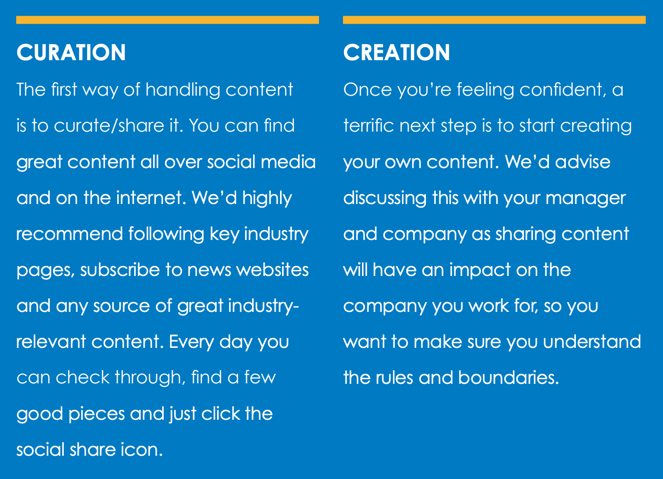
DANIEL's CONTENT TOP TIPS |
|
|
Want to get the most out of content? You need to share your content at least every two weeks; however, weekly would be ideal. The key is consistency, so set a cadence and stick to it. A cadence will help ensure you’re at the front of your prospect’s mind and adding as much value to them as possible |
|
|
You’re working in sales, so you should be super busy! If that means you’re too busy to spend time each day sharing content, no worries! You can auto-schedule in advance so that it works for you, while you’re working on other sales or social activities. Check out Hootsuite or Buffer; hey are both super easy to use and are great tools. |
|
|
The more content that you consume, the better content you’ll find, and the better you’ll get at creating your own great content. An easy way to do this is by subscribing to industry news outlets, and the information will be delivered directly to your inbox. Share different forms of content, and keep your network engaged by mixing it up a little. For example, one day it might be an article, the next day a long-form status, the next day a video, etc. |
|
|
Sharing blogs is a great way to give a big amount of value. Either find awesome blogs that are packed with relevant value and content for your prospect or create your own. |
|
|
Video is already a hugely popular form of content and is currently being boosted by the LinkedIn algorithm. Record short 1-3 minute videos packed with content that is valuable to your prospect that includes insights, tips and stories. |
Do you have a sales playbook or documented sales approach? Below, we’ve outlined some of the basic stages to think about for successful social selling with cold calling outreach.
One common tactic while prospecting is seeking out conversation starters and common ground. If you’re walking into someone’s office, you might look for photos of family, paraphernalia from sports teams or even books.
Online, a lot of that information is available within their social media profiles and content. With a little social research, you can warm up those cold calls using the following types of information you can often find on social profiles:
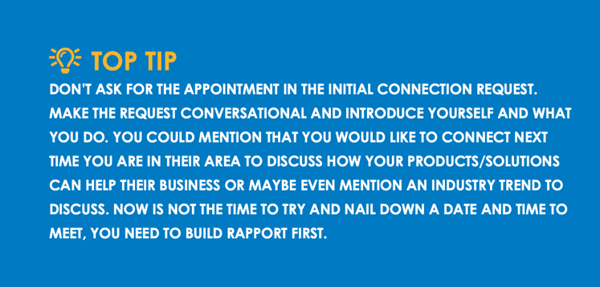
Making sure that you are targeting the right customer and offering the
solutions that will maximise their profits is critical in building a funnel of profitable prospects. It is important to understand your prospects’ needs and how you can help them to attain their goals and initiatives.
To prepare and make sure that you are not calling on the wrong prospects or offering them solutions that don’t fit their needs, do your research. There are many methods that you can use to do this research, and a good place to start is on the internet. These days, all companies have websites, and most have a social media presence.
 Look at the prospects’ company websites to know what they do. See how they engage with their followers on social media, what events are they talking about or hosting. Their interactions and events are vital clues to how you may be able to help with your solution or product.
Look at the prospects’ company websites to know what they do. See how they engage with their followers on social media, what events are they talking about or hosting. Their interactions and events are vital clues to how you may be able to help with your solution or product.
For example, if you sell custom-made widgets and you notice that they have a public event coming up, this becomes the perfect opportunity to talk about your product and how it can help them to advertise and keep their business in people’s minds after they leave the event. Knowing your prospect’s information before going into a meeting shows that you understand their business and have done your homework.
It is also important to ask your current customers for any information on their peers and initiatives that they may have going on. They will likely know better than anyone since it is their job to know what their competition is doing just like it is your job to do the same.
We will also mention here that LinkedIn engagement and connection is always a good idea. Don’t be shy about reaching out to prospects, introducing yourself and asking for a connection. Often if worded correctly in the connection request, you can get an appointment easier when the time comes.
You have done your research, and know what the prospect’s goals and initiatives are. Now it’s time to set an appointment and determine your cadence for sales engagement and follow up. However, the bestlaid plans can go south quickly. It is best to reach out to the prospect via phone first then follow up with an email or a private message on social media. We would not recommend a text at this point since you have not established a relationship with them, and text tends to be a more personal form of communication.
 If the meeting is more than a couple of weeks away, be sure to follow up and stay engaged with them. Once you have the meeting, be sure that you truly know the prospect’s business. They will test you on it. More importantly, be prepared to listen more than you talk. Have scripted, open-ended questions prepared beforehand that dig deeper into their business and be ready to change your approach based on the conversation.
If the meeting is more than a couple of weeks away, be sure to follow up and stay engaged with them. Once you have the meeting, be sure that you truly know the prospect’s business. They will test you on it. More importantly, be prepared to listen more than you talk. Have scripted, open-ended questions prepared beforehand that dig deeper into their business and be ready to change your approach based on the conversation.
The prospect is not expecting you to come in with guns blazing to help solve all their problems at the first meeting. However, they do want you to be prepared and be ready to answer any questions. They want you to listen and understand their business and their needs, if that means scheduling a follow-up meeting to talk about your solutions, then that is what it takes.
Be sure and stay engaged in the conversation and listen carefully for clues on what they are looking for and how fast they want to move on the project. These clues will help you in determining if you need to adjust your follow up schedule or your approach with the customer. Be sure and ask open-ended questions and take notes. These notes will be used later to make sure that you are documenting your visit as well as following up on items properly, so they don’t have to be perfect. In other words, don’t get so caught up in writing that you miss something in the conversation.
Follow up and consistency is key in leading the prospect to becoming a loyal customer. Be sure that you reach out to the prospect immediately following (no more than 12 hours) the meeting and thank them for their time. Also, be sure and let them know that you look forward to continuing the conversation and Sales Engagement, Simplified 16
Prospecting through Post-Call Follow Up The Ultimate Guide to Prospecting review any critical points from the meeting that you may be checking into or that may be relevant to the next meeting. If there are items that they were going to get back to you on, be sure and outline these and include date expectations as well. It is important that you set a clear sales cadence expectation and stick to it to keep them engaged and keep the momentum moving forward. An email template can be set up for this follow-up, just be sure that you are putting in the information that pertains to the particular customer and not making it too generic.
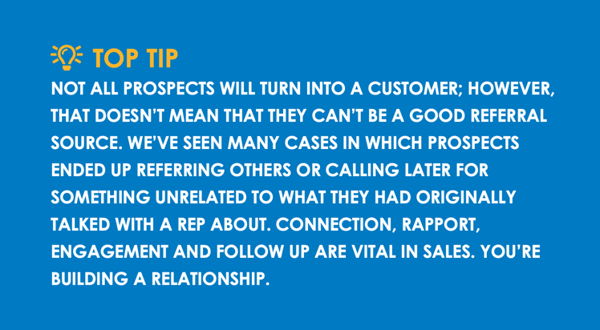
Staying engaged with the prospect and later customer will help you to build a stronger funnel and referral network. Stay in contact with the prospect but don’t overdo it. Statistically, 80% of sales are made after the fifth contact and before the twelfth, but only 12% of salespeople follow up more than three times. It’s extremely important to stay consistent and keep engaging after that first cold call.
A few critical factors in increasing engagement is making sure that you are connected on social media. As previously mentioned, building relationships by posting engaging, relevant content and posting positive, helpful comments on your prospect’s posts help build rapport.
One of the biggest challenges in integrating social selling is finding time to do it. For many salespeople and sales teams out there, their days are already fully booked! Where are you supposed to find time to write blogs, engage in content, add people and research them? The first thing to realise is that to be successful on social doesn’t require you to spend hours and hours each day on LinkedIn. You achieve amazing results from as little as 30 minutes per day. The key is to schedule it in around what you’re already doing.
For example, during your scheduled email time, spend some time researching social media or looking at industry news. You can also plan some time at the beginning of the day to go over what you want to accomplish for the day, your schedule and catching up on industry news. Since you are doing this at the beginning of the day, it is normally before other distractions taking over your time. Also, as you have a break during the day, take the time to scan social media.
Most importantly, treat social media time as prospecting and research time. It is key to understanding your sales funnel.
Technology is an essential tool in your toolbox, use it often and use it wisely. Phone and computers have come a long way since the beginning, and the technology has only gotten smarter. Text, email, social media, phone calls and web searches are all being done mostly via cell phone, tablet or laptop.

Maybe your company has invested in a customer relationship management (CRM) solution; that’s a great start, but it’s only a start. CRM is a system of record. Winning sales teams invest in sales engagement solutions that actively help them make more calls, set more appointments, and make more sales. They also ensure each contact is immediately engaged with a consistent cadence of touches that span phone, email and social media. Sales engagement forces you to actually ‘engage’, thereby relieving you of the burden of manually scheduling tasks to do that. With sales engagement, you don’t have to remember to connect with your contacts.
👉 Build a social media profile that will make prospects want to do business with you.
👉 Start building your network of connections with prospects, influencers and even competitors.
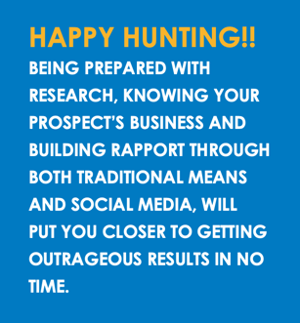 👉 Engage with relevant content to demonstrate your subject matter expertise.
👉 Engage with relevant content to demonstrate your subject matter expertise.
👉 Practice sales calls through roleplaying with a colleague or your manager.
👉 Listen to recordings of your calls -- with a colleague or your manager if possible -- and critique your performance. Make a note of successes and areas for improvement.
👉 Reach out, make appointments, and RESEARCH prospects.
👉 Set up a cadence for sales engagement that includes varying forms of communication including social selling and cold calling. Remember: don’t use just one, use MANY.
👉 Be persistent and consistent.
👉 Build a profile document with scripted open-ended questions, and make notes on this to put in your sales engagement platform to help you remember to follow up on items for your email later
👉 FOLLOW UP, FOLLOW UP, FOLLOW UP!! This action is very important in your sales engagement and cadence!
I am extremely impressed with how easy it was to get started and train my marketers on the VanillaSoft solution. As well, I had a lot of flexibilityon how I wanted this program to run for our company. Plus, customer service is EXCELLENT at VanillaSoft. I highly recommend VanillaSoft to anyone!

Jody Weinberg J Telecommunications
We have never been so successful. Since we started using VanillaSoft we have increased productivity by 175%! Also, working with the VanillaSoft team has been an incredible experience. They helped us customized our campaigns and page layout to fit our unique needs.

Lauren E. Siegel Hillel Michigan